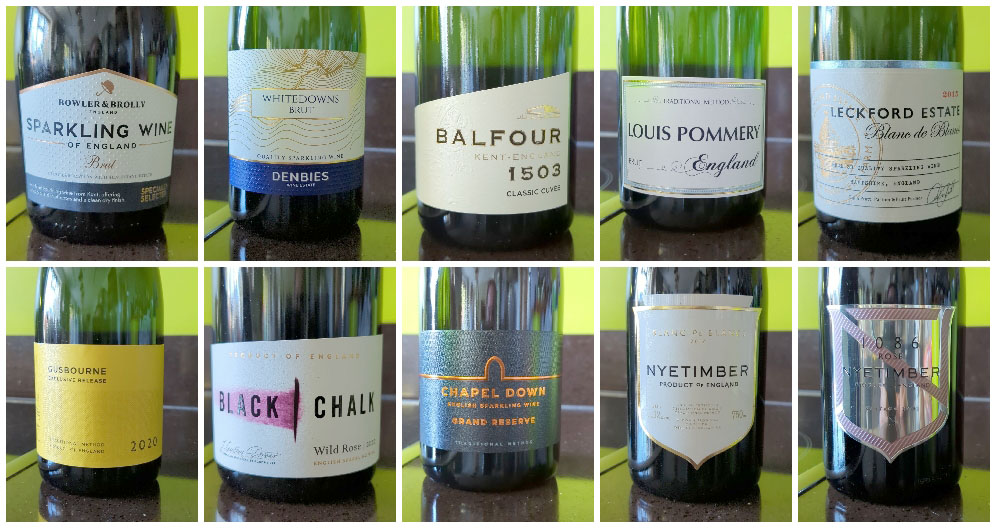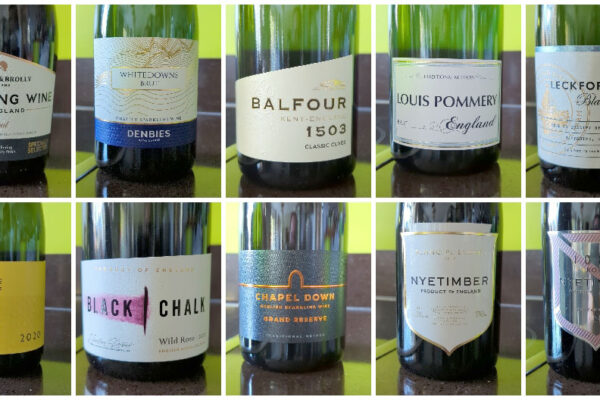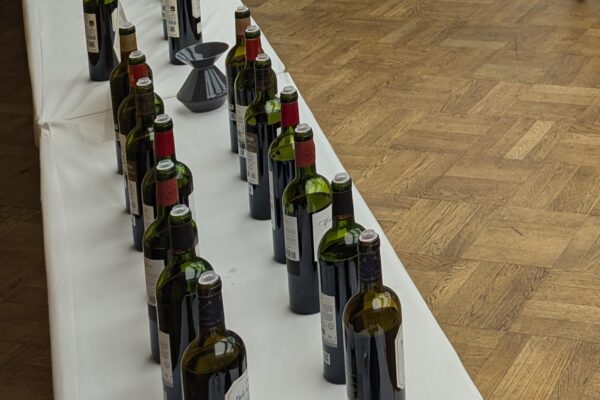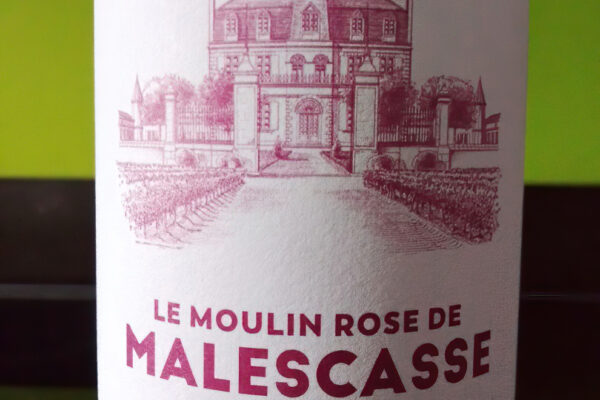This review began when Nyetimber kindly offered to send me some bottles for tasting, which led me to wonder whether I could broaden the scope to include a wider range of English Sparkling Wines. I was keen to explore the differences between Charmat and Traditional Method wines, and to compare various styles – rosé, vintage and non-vintage, as well as wines with some age behind them. With the festive season fast approaching, it felt like the perfect moment to take on the task.
I reached out to a handful of PR agencies, vineyards and retailers to request additional samples and enlisted some friends and family members, each with an interest in wine, to help compare them. The resulting selection spanned an extraordinary price range, from £10 to £175.
Although all the wines shared a broadly similar style, I asked the group to pay particular attention to the colour, bubbles, aroma, flavour, autolytic character (those toasty, bready, brioche-like notes that develop from the breakdown of yeast), texture, sweetness and the shape or progression of the wine through the taste.

Bowler and Brolly English Sparkling NV 11% £9.99 Aldi
This is the only wine in the selection made using the Charmat method, where the second fermentation happens in a large tank rather than in individual bottles. It’s a quicker process, typically lasting no more than three months, and significantly cheaper as it avoids long-term storage costs.
A new listing from Aldi, this one is produced by Silverhand Estate in Kent and made from a blend of 50% Chardonnay, 25% Pinot Noir and 25% Pinot Meunier, the classic combination for English Sparkling and Champagne. The wine has 12g/l residual sugar, placing it at the sweeter end of the spectrum. It’s pale in colour, with very small bubbles that faded quickly. It has green apple and lemon on the aroma, with an apple-driven flavour and a hint of honey. There’s little to no autolytic character here and the texture is thin and crisp with noticeable sweetness.
Compared with Silverhand’s own brand Charmat Silver Reign Brut (£17), that I happened to sample the day before at WineAlive, this comes across as a simpler version. As an aside, the traditional method sparkling wine from the same producer was excellent. Charmat wines like this one remain somewhat controversial in the UK, with some producers worried it might undermine the reputation of English Sparkling overall.
Denbies Whitedowns Brut NV 11.5% £20
From Dorking in Surrey, this is a traditional method sparkling wine with an unusual twist. The grape blend includes Seyval, Reichensteiner, and Pinot Noir, and the wine at 11g/l residual sugar, makes it slightly less sweet than the Bowler and Brolly. It’s pale in appearance, with slightly larger, lively bubbles and a very frothy texture. On the aroma, it’s yeasty with a note of unripe greengage. The flavour is fresh and literally yeasty with a distinct nuttiness from time on the lees. It finishes dry. Available from Denbies and Waitrose Cellar.
Balfour ‘1503’ Brut Kent NV 12% £24
Named after the year Hush Heath Manor was built, this wine comes from Kent and combines 56% Chardonnay, 23% Pinot Noir, 13% Pinot Blanc and 7% Pinot Meunier. With 11g/l residual sugar, it falls within the classic brut style. The colour is very pale, almost clear and the bubbles are tiny and plentiful. There’s an apple aroma and a flavour profile that blends apple, lemon, buttery notes and brioche. The texture is slightly creamy and the wine comes across as gently sweet. More rounded in the mouth than the previous wines, and available at Majestic.
Louis Pommery Brut England NV 12.5% £30
From Hampshire, this is the first English sparkling wine from a Champagne house. The blend is 55% Chardonnay, 37% Pinot Noir and 8% Pinot Meunier, with 8g/l residual sugar. Very pale in colour, it has slightly larger bubbles and a prominent apple and brioche aroma. Flavours of melon, brioche and almond carry through, with a creamy mouthfeel. Despite the lower sugar, it still gives the impression of slight sweetness. Available at Majestic.
Leckford Estate Blanc de Blancs NV 12% £35
Made from 100% Chardonnay grown at Waitrose’s own Leckford Estate and vinified at Ridgeview, this non-vintage sparkling wine is based on the excellent 2015 harvest. It contains 8g/l residual sugar. More yellow in tone, though still pale, the bubbles are small and very long-lasting. On the nose there’s baked apple, acacia and honey. The taste includes brioche and ripened apricot, with a smooth and silky texture that carries through to a long, nutty finish. Particularly good with food. Ridgeview, who made this wine, have recently entered administration, highlighting the financial pressure many producers face in this sector. Available from Waitrose.
Gusbourne Exclusive Release 2020 12.5% £42
This was the first vintage sparkling wine tasted, and comes from Appledore, Kent. Vintage wines reflect the conditions of a single harvest, and 2020 was hot and dry, producing ripe grapes. The blend is 78% Chardonnay, 17% Pinot Noir and 5% Pinot Meunier, with 7.5g/l residual sugar. The wine spent 24 months on the lees, which contributes to finer bubbles and a more layered taste. Very pale in colour, it opens with apple on the aroma. The flavour includes baked apple and nutty elements, with mild buttery and shortbread-like characteristics. It’s slightly creamy and silky, with a hint of sweetness. Available at Waitrose.
Black Chalk Wild Rose 2022 12% £45
A vintage rosé from a very hot and dry 2022, this comes from the Test Valley near Andover in Hampshire. It’s made from 57% Pinot Noir, 36% Pinot Meunier and 7% Chardonnay, with 7.5g/l residual sugar. Aged 22 months on lees and partially aged in oak barrels, it stands out for its depth and complexity. The colour is a delicate pale blush, with fine, persistent bubbles, especially noticeable on the tongue. There’s an inviting rhubarb aroma and a redcurrant-driven flavour. Crisp at first, it softens and becomes more rounded in the mouth as it warms. Very well balanced. Available from Lea & Sandeman, The Wine Society, Loki Wine, Reserve Wines, Vinotopia, The Wee Vinoteca and Grape Britannia.
Chapel Down Grand Reserve 2019 12% £50
Chapel Down’s premium-tier wine made from 55% Chardonnay, 34% Pinot Noir and 11% Meunier. The 2019 season has mixed weather but delivered good fruit. The Grand Reserve includes some reserve wines aged in both barrel and tank, adding depth and complexity. Aged for at least three years in bottle. It pours pale with very fine bubbles. The aroma blends apple and brioche, while the flavour is layered with honey and brioche and a deeper note in the middle, possibly apricot. Very rounded, balanced and creamy with a long smooth finish. Despite the crispness, there’s no harsh edge. Recently, in a blind tasting in New York, 67% of participants preferred Chapel Down Brut to a leading Champagne brand. Widely available.
Nyetimber Blanc de Blancs 2017 12% £58
This vintage, 100% Chardonnay wine contains 10g/l residual sugar. The 2017 growing season was mixed, with a damaging spring frost followed by a hot summer. Aged for over three years on lees, it also includes a small proportion of barrel-fermented Chardonnay. The estate, dating back to the Domesday Book, is one of the most established in England, with vineyards in Sussex, Hampshire and Kent. Pale in colour with fine bubbles, the wine has aromas of honey, apples and lemon curd. Flavours include brioche, honey and melon. The texture is refined, balancing dry structure with a creamy and very smooth finish. Available from Nyetimber.com, Hennings Wine, Amathus, Jeroboams and Lea & Sandeman.
1086 by Nyetimber Rosé 2014 12% £175
A rare vintage rosé from what was described as a dream growing year. The bottle has a weighty, near-opaque presence, finished with thick metal label that suit its premium price. The blend is 50% Pinot Noir and 50% Chardonnay, with 9.5g/l residual sugar. Made only from the finest parcels in exceptional years and sourced entirely from Nyetimber’s Sussex vineyards. The wine is pale gold in colour and delivers a rich tasting journey. Aromas include strawberry, poached pear, baked bread and honey. The flavour brings wild strawberry, redcurrant, almond and buttered pastry. There’s a balanced sweetness and a very smooth, long finish. Positioned as the pinnacle of Nyetimber’s winemaking. Available from Nyetimber.com, Hennings Wine, Amathus, Jeroboams and Lea & Sandeman.
Some general conclusions emerged from the tasting. Charmat method wine lacked the distinctive autolytic character. Unsurprisingly, rosés tended to show more prominent red fruit notes. The more expensive bottles, particularly those with extended lees ageing, displayed greater brioche character. Wines that had been aged longer also revealed more honeyed and almond notes. It was interesting that differences between vintages made little impression, perhaps because the winemaking smoothed out any extremes, and in any case most producers tend to bottle their wines only in the stronger years. A consistent trend was that the more expensive the wine, the more nuanced and balanced the tasting experience became, offering more of a journey during the taste.
When it came to best value for money, the clear winner was the Aldi Browler & Brolly at just £10, even though it lacked much in the way of Champagne-like character, but offered excellent quality for the price. The Leckford (£35) followed closely, with four wines sharing third place: Chapel Down (£50), Nyetimber (£58), Balfour (£24) and Louis Pommery (£30).
So this holiday season, if you’re considering Champagne, it may be worth exploring English Sparkling Wine as a more exciting and locally supportive alternative. With such variety and quality on offer, there’s every reason to celebrate British winemaking.













